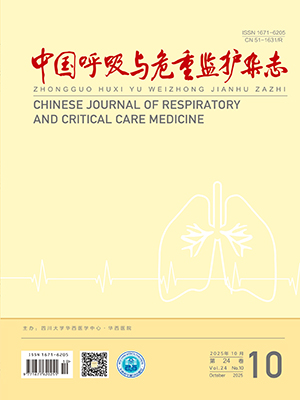| 1. |
Ruuskanen O, Lahti E, Jennings LC, et al. Viral pneumonia. Lancet, 2011, 377(9773): 1264-1275.
|
| 2. |
Chatterjee S, Khunti K, Davies MJ. Type 2 diabetes. Lancet, 2017, 389(10085): 2239-2251.
|
| 3. |
杨文英. 中国糖尿病的流行特点及变化趋势. 中国科学(生命科学), 2018, 48(8): 812-819.
|
| 4. |
Febbo J, Revels J, Ketai L. Viral pneumonias. Radiologic Clinics, 2022, 60(3): 383-397.
|
| 5. |
Badawi A, Ryoo SG. Prevalence of comorbidities in the Middle East respiratory syndrome coronavirus (MERS-CoV): a systematic review and meta-analysis. Int J Infect Dis, 2016, 49: 129-133.
|
| 6. |
Ma CM, Wang N, Su QW, et al. The Performance of CURB-65 and PSI for Predicting In-Hospital Mortality of Community-Acquired Pneumonia in Patients with Type 2 Diabetes Compared with the Non-Diabetic Population. Diabetes Metab Syndr Obes, 2021, 14: 1359-1366.
|
| 7. |
林秀慧, 张根生, 崔巍. 病毒性肺炎的诊治进展. 中国现代医生, 2017, 55(05): 163-168.
|
| 8. |
陈子怡, 谭文芝, 郑金海, 吴昊, 文李. 糖尿病诊断及治疗策略探讨. 生命科学, 2024, 36(11): 1420-1427.
|
| 9. |
Kumar A, Arora A, Sharma P, et al. Is diabetes mellitus associated with mortality and severity of COVID-19? A meta-analysis. Diabetes & Metabolic Syndrome: Clinical Research & Reviews, 2020, 14(4): 535-545.
|
| 10. |
Kuitert, LM. The lung in diabetes–yet another target organ?Chron Respir Dis, 2008, 5(2): 67-68.
|
| 11. |
Ma CM, Wang N, Su QW, et al. Age, Pulse, Urea and Albumin (APUA) Model: A Tool for Predicting in-Hospital Mortality of Community-Acquired Pneumonia Adapted for Patients with Type 2 Diabetes. Diabetes Metab Syndr Obes, 2020, 13: 3617-3626.
|
| 12. |
Qin W, Bai W, Liu K, et al. Clinical Course and Risk Factors of Disease Deterioration in Critically Ill Patients with COVID-19. Hum Gene Ther, 2021, 32(5-6): 310-315.
|
| 13. |
Niederman MS, Cilloniz C. Aspiration pneumonia. Revista Espanola de Quimioterapia, 2022, 35(Suppl 1): 73.
|
| 14. |
Josefs T, Barrett TJ, Brown EJ, et al. Neutrophil extracellular traps promote macrophage inflammation and impair atherosclerosis resolution in diabetic mice. JCI Insight. 2020, 5(7): e134796.
|
| 15. |
Baker, EH, Baines DL. Airway glucose homeostasis: a new target in the prevention and treatment of pulmonary infection. Chest, 2018, 153(2): 507-514.
|
| 16. |
Nobs SP, Kolodziejczyk AA, Adler L, et al. Lung dendritic-cell metabolism underlies susceptibility to viral infection in diabetes. Nature, 2023, 624(7992): 645-652.
|
| 17. |
Zhang H, Wang Y, Qu M, et al. Neutrophil, neutrophil extracellular traps and endothelial cell dysfunction in sepsis. Clin Transl Med, 2023, 13(1): e1170.
|
| 18. |
王瑾茜, 喻嵘, 黄娟, 等. 基于CiteSpace的中性粒细胞在糖尿病领域研究进展可视化分析. 中国比较医学杂志, 2024, 34(6): 28-39.
|
| 19. |
Foster D J, Ravikumar P, Bellotto D J, et al. Fatty diabetic lung: altered alveolar structure and surfactant protein expression. Am J Physiol Lung Cell Mol Physiol, 2010, 298(3): L392-403.
|
| 20. |
占林兵, 谢波, 华锋, 等. 血清C反应蛋白、降钙素原及乳酸在重症肺炎中的变化及临床意义. 中华全科医学, 2015, 13(3): 367-368+404.
|
| 21. |
Cure E, Cumhur Cure M. COVID-19 may affect the endocrine pancreas by activating Na+/H+ exchanger 2 and increasing lactate levels. J Endocrinol Invest, 2020, 43(8): 1167-1168.
|
| 22. |
冯剑波, 邓卓行, 郑权, 等. 血乳酸、白介素-10、降钙素原水平对重症肺炎的诊断和预后评估价值. 中国当代医药, 2023, 30(29): 150-154.
|
| 23. |
Zhang L, Jiang F, Xie Y, et al. Diabetic endothelial microangiopathy and pulmonary dysfunction. Front Endocrinol(Lausanne), 2023, 14: 1073878.
|
| 24. |
Peng Q, Shan D, Cui K, et al. The role of endothelial-to-mesenchymal transition in cardiovascular disease. Cells, 2022, 11(11): 1834.
|
| 25. |
Zafari AM, Ushio-Fukai M, Akers M, et al. Role of NADH/NADPH oxidase–derived H2O2 in angiotensin II–induced vascular hypertrophy. Hypertension, 1998, 32(3): 488-495.
|
| 26. |
蒋华龙. BNP、APACHEⅡ评分联合LUS评分在重症肺炎中的临床应用研究. 吉林大学, 2022.
|
| 27. |
林春生, 王世红. 老年心力衰竭患者肺部感染病原菌分布、危险因素及其对PCT、BNP、D-D的影响. 中国病原生物学杂志, 2019, 14(11): 1332-1334+1338.
|




